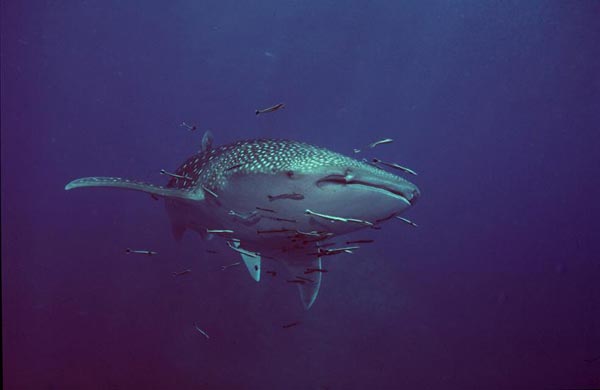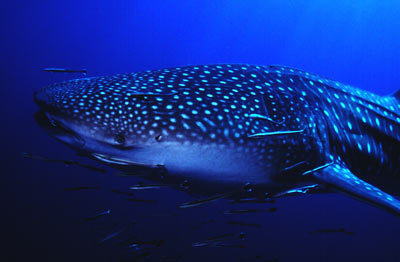
A Whale Shark swimming near Richelieu Rock
The
Sharks of Thailand
By Lars
Bindholt
Home Species Whale sharks where?
WHALE SHARK (Rhincodon typus)

A Whale Shark swimming near
Richelieu Rock
Thailand
was until recently one of the best places in the world to spot this shark,
the biggest of all fishes. It is a huge gentle active plankton feeder, which
surrounds schools of small fish and (in some waters) shrimps, and then engulf
them by the thousands. Is often followed by remoras and Cobias. Was every year,
especially in the spring, seen from Hin Daeng, Racha Islands, Phi Phi Islands,
Patong (Phuket), to Similans and Surin Islands.
In the Similans-Surins area most
Whale Sharks are seen around Koh Tachai and Richelieu Rock. The sightings at
Richelieu Rock dropped markedly in the 1996-97 season coinciding which a huge
increase in visiting dive boats. Only very few sharks were seen there compared
to earlier years. But it was hardly surprising with 4-5 boats there most of the
time in the high season. Some of them moored right at the rock all day with
engines (for aircon) creating a lot of noise. Many operators at that time did
not discourage their divers from touching the sharks.
In
the 1997-98 season the sharks were again spotted very frequently, and this may
very well be due to the fact of hard efforts to keep divers from touching and
disturbing the big animals. Please don't ride the Whale Sharks. They will dive
and disappear, as they really don't like it. Watch and enjoy, and the Whale
Sharks will stay.
The place of all places I have seen most Whale Sharks is the crowded tourist bay
of Patong on the west coast of Phuket. In December 1993, early spring 1996 and
again in December 1997, the bay was
feeding place for at least 5-6 Whale Sharks, which was seen by an increasing
number of snorkelers and longtail- and jet ski riders every day for several
weeks. Eventually the small yellow fish, they were feeding on, became scarcer as
the annoyance from spectators grew bigger, and one day the gentle giants were
gone. None of them would be followed out to sea by the big Cobias, which
accompanied them into the bay, as these were quickly shot by spear gunners.

Whale Shark with lots of remoras
around it.
In 1993 one of the Whale sharks were severely wounded by the propellers of
probably a speedboat. That did not happen in 1996, and the longtail drivers (who
made a small fortune taking people out to the sharks only a couple of hundred
meters from the beach) really tried not to disturb the sharks too much. The
major danger to the Whale Sharks (and the swimmers) were the big speedboats, and
again in 1997 one of the whale sharks were injured, probably by a speedboat. The
sharks could be seen when they, after having surrounded and packed a school of
fish together, started to eat them from below coming to the surface trashing
their big tails around.
I was swimming about 1 meter from the mouth of a whaleshark. In front of it was
several thousands small yellow fish. They were not panicking, maybe because the
shark was too big to be associated with dangerous predators. The shark opened
the mouth and many hundreds fish was sucked in. I looked inside the mouth and
saw they were still swimming along, same direction. The big mouth shut, and when
it opened again, none of the fish were there.
A big cloud of bubbles from a diver sometimes fools a Whale Shark into the
belief, that it is small fish, and it will go for them engulfing them while
following them to the surface. This I have watched on several occasions at
Richelieu Rock.
Something
sad has happened recently. The markets, especially the Chinese has opened up for
using whale Shark meat and Whale Shark fins and the price has gone up makedly.
As a result the fishery directly after Whale Sharks has exploded. The Taiwanese
markets now sell Whale Shark meat as Tofu Shark. The biggest fisheries after
Whale Shark is going on in India, where in 1998 along one coast more than 1000
Whale Sharks were killed. No regulations whatsoever. The fishery goes on today.
In the Phillipinnes the Whale Sharks are also hunted allthough they are
protected by law. The fines are far too small to stop the killings as you can
get more than 10 times more for one Whale Shark.
In Thailand there is no tradition for catching these animals. In my time
there I have never heard of one being captured. It is the same in neighboring
countries as Burma and Malaysia, but recently local fishermen has caught Whale
Sharks for money offered by foreign businessmen who resale the meat to Japanese
and Chinese dealers. For that reason Burma has now made Whale Sharks a protected
species. We can only hope that the law some day can be enforced.
We have a couple of times observed Whale Sharks with a rope tied
around the tail. This will eventually kill the shark as it slowly but surely
cuts of the tail. On one of the sharks it already cut 2-3 centimetres into the
flesh.
The
Taiwanese, who operates huge fishing boats all over the world with big driftnets,
are known to take every living creature in the sea. Even Whale Sharks. In 1997 a
Taiwanese fishing operation fishing the North coast of Sulawesi caught with big
driftnets a numbert of Whale Sharks (and hundreds of other big creatures as Mantas,
dolphins e.t.c.). This has now been stopped.
The increased fishery in the Far East is probably the main reason for the big
decrease in Whale Shark sightings in Thai waters recently. In 2001 not a single
Whale Shark was spotted from Phi Phi Islands and the sightings from the other
areas were few.
The Whale Shark grows to 13-15 meters.
On Whaleshark.org There is a big photo ID file the individual whale sharks are identified. If you have photos of whale sharks, please mail these to this site.
The whale sharks T-001, T-002, T-003 og T-004 are "mine". Until now there are 170 Thai-whale sharks with an average size at 4,5 m. The biggest is 9,5 m and the smallest 2,5 m of length. Mail your photos to: Wildbook for whale sharks
Go to Observations of whale sharks
Video
clip from Richelieu Rock
LINKS: